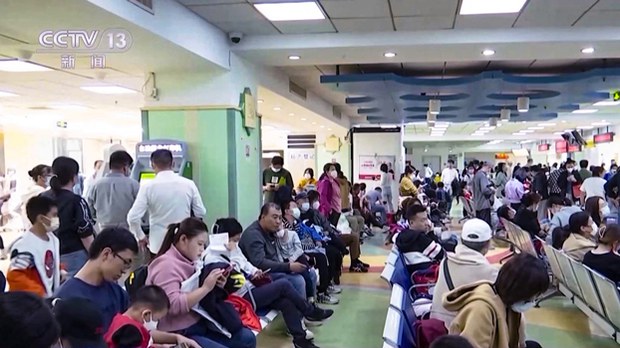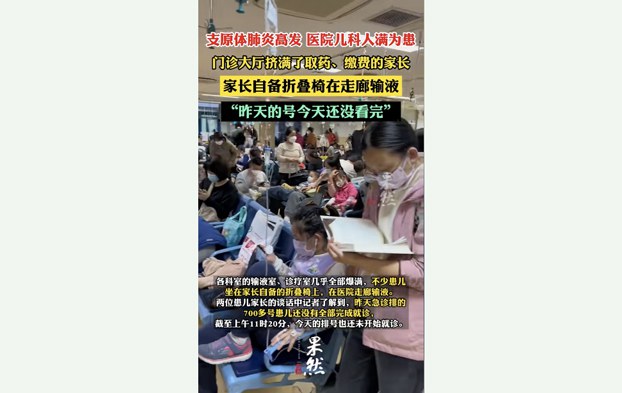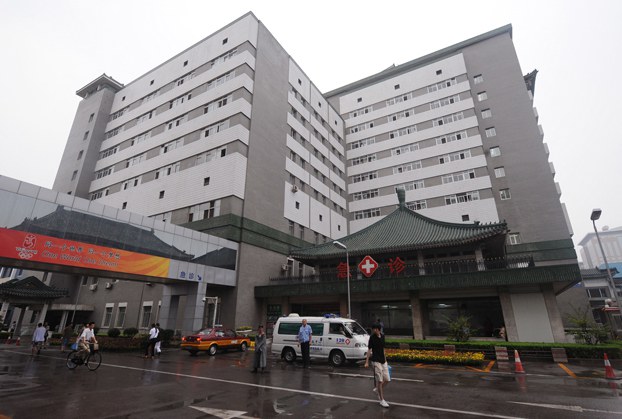Chinese hospitals swamped with severe child pneumonia cases
Share

A crowded hospital in China is seen in this undated photo amid an outbreak of severe cases of pneumonia in children.
Hospitals in northern China are currently overwhelmed by thousands of children suffering from a bacterial form of pneumonia that is causing a resurgence of severe illness following a lull during three years of zero-COVID restrictions, doctors and health experts told Radio Free Asia on Wednesday.
The Beijing Center for Disease Control and Prevention said that more than 3,500 cases of “respiratory infection” had been admitted to the Beijing Children’s Hospital at the beginning of the month, while media reports blamed the outbreak on Mycoplasma pneumoniae, an atypical bacterium that causes lung infection.
Photos and video clips posted to social media from Beijing and Tianjin showed hospital waiting rooms crowded with people, many holding children, amid unconfirmed social media reports that many cases are showing ground glass opacity in lung scans – an indicator of severe respiratory illness.
The majority of cases seem to be children, with worried parents flooding hospital phone lines and waiting rooms, yet having to wait at least a day even for emergency care.
An employee who answered the phone at the Beijing Friendship Hospital pediatrics department said there is currently a 24-hour wait for emergency cases to be seen.
“They’re still dealing with calls we took yesterday,” the employee said. “They haven’t even started on today’s calls yet – there are at least 1,000 people waiting in the queue ahead of you.”
“The calls coming in today won’t get seen until tomorrow … We’re taking more than 1,000 calls a day.”
The department is staffed with just three doctors in the pediatric outpatient clinic and two in the emergency room, the employee said.
“If you were to register now [for treatment], you wouldn’t get seen until 5 p.m.or 6 p.m. tomorrow,” they said.
Limited number of slots
An employee who answered the phone at the Beijing New Century Children’s Hospital had a similar story.
“Wait times are extremely long right now … there are no more appointment slots today,” they said. “If you come in and line up to get an appointment, you will have to wait at least four hours.”
An employee who answered the phone at Tianjin’s Beichen Hospital said there are no more appointments there, either.
“There are no more slots – even the additional slots are all full,” they said.


Meanwhile, an employee at the Tianjin Children’s Hospital said it had shut its doors to new cases by 2.30 p.m. local time on Wednesday.
“We don’t have an emergency department, and we’re closed now,” the person said.
“We can’t see everybody, and the doctors get off work at 4 p.m.,” they said. “There are too many patients and we only have two doctors.”
Seasonal peak
Chinese health officials on Monday warned that the country is now experiencing a peak of seasonal respiratory disease, with National Health Commission spokesperson Mi Feng calling on health officials to step up monitoring for M. pneumoniae, COVID-19 and seasonal influenza.
Monitoring data show that there is growing influenza in both the northern and southern regions, with H3N2 currently the dominant strain, state news agency Xinhua quoted National Influenza Center chief Wang Dayan as saying.
According to Patrick Meyer Sauteur and Michael Beeton of the European Society of Clinical Microbiology and Infectious Diseases, Mycoplasma pneumoniae was a common cause of respiratory infections before the COVID-19 pandemic, with worldwide incidence of 8.61% from 2017 to 2020.
“However, non-pharmaceutical interventions against COVID-19 drastically lowered the transmission of M pneumoniae,” they wrote in The Lancet medical journal in August 2022.
The authors warned that “If M pneumoniae infections resurge, they might affect the world population, which has not been exposed to M pneumoniae for the past 3 years, and result in an increase in rare severe disease.”
Mi Ying, deputy chief physician of pediatrics at Peking Union Medical College Hospital, told the Workers’ Daily on Nov. 15 that the bug can cause “mild, severe, or even critical illness.”
“The severity isn’t just related to the invasion by the pathogen, but to the person’s immune response,” he said.


It was unclear whether the severity of the outbreak is linked to the mass infection and reinfection of China’s population with the Omicron variant of COVID-19 immediately following the lifting of nationwide zero-COVID restrictions in December 2022.
Some medical journals have reported coinfection with COVID-19 and M. pneumoniae, while others have pointed to weakened immunity from infection and reinfection with COVID-19, which has also been linked to recent surges in other respiratory infections in children.
Mi said people should wear masks, wash their hands frequently and ventilate crowded public spaces “to minimize the risk of infection.”
Outbreak is worse than usual
In an interview published on the Beijing municipal government website, Beijing Friendship Hospital pediatrics expert Wei Tianli said this year’s outbreak is worse than usual “because the inflammatory response in the lungs is relatively severe … across a relatively large area,” making it harder to breathe.
Taiwan pediatrician Huang Li-min said children are more vulnerable to infection with mycoplasma pneumonia, yet the infection tends to transmit within households, affecting the adults, too.
“Recently, it has become more pathogenic due to mutations,” Huang said. “Cases are higher, and more serious, causing an outbreak, with some people needing hospitalization.”
“Members of the same family often catch it, one after another,” she said, adding that Asia seems to be seeing a more mutated and pathogenic form of M. pneumoniae than Europe.
“Once lockdown was lifted, respiratory diseases made a comeback,” Huang said, adding that China is in deeper trouble than some places, due to high levels of antibiotic resistance in the population.
“Drug resistance means that oral antibiotics are no longer effective, so people have to rush to the hospital, to the ER,” Huang said. “So, large numbers of patients turn up in a short space of time, causing crowds at hospitals.”
Taiwan-based dissident Gong Yujian, who has contacts in China’s medical system, said there is still a severe shortage of medical personnel, supplies and equipment in China, with many medical staff reluctant to work due to corruption, and a hierarchical medical system that offers patchy provision of care depending on how affluent someone is, and on where they live.
A Beijing resident who gave only the surname Li for fear of reprisals confirmed Gong’s account, saying smaller clinics and community hospitals are easily overwhelmed by sudden outbreaks of disease.
“There is also a kind of superstitious thinking people have now which says that you should definitely go to a bigger hospital for more serious illnesses, for peace of mind,” she said.
Translated with additional reporting by Luisetta Mudie. Edited by Roseanne Gerin.







